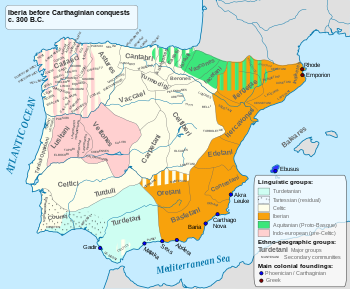
The Bardili were a small, pre-Roman tribe of the Iberian Peninsula, and an offshoot of the widespread Turduli people, who lived in what is now southwestern Portugal in the 5th-1st centuries BC.
Location
Migrating in conjunction with the Celtici, they settled the present Setúbal peninsula along the Tagus river mouth and the lower Sardum (Sado; Kallipos in the Greek sources) river valley around the 5th Century BC, where they founded several coastal towns. The exact location of the Bardili capital Bardo remains uncertain, though the towns of Equabona/Aquabona (Coina-a-Velha), Caetobriga/Cetobriga (Monte da Rotura, near Setúbal) and Salacia (Alcácer do Sal; Iberian-type mint: Ketuvion) have all been identified.
History
In the mid-3rd century BC the Bardili were forced to acknowledge the suzerainty of Carthage at the latter part of the century. However, their history after the Second Punic War is unclear; they seem to have played no role in the Lusitanian Wars and subsequent conflicts during the 2nd-1st Centuries BC. It is almost certain that the Bardili recovered their independence, which they enjoyed for nearly a century before being included into Hispania Ulterior province by the Praetor Publius Licinius Crassus in the wake of his campaign against the Lusitani and Celtici in 93 BC. Later during the Sertorian Wars in 79 BC, Proconsul Quintus Caecilius Metellus Pius established a permanent military base at Caeciliana (near Setúbal), in order to prevent the Bardili from lending their support to Quintus Sertorius.
Romanization
Increasingly Romanized after the Ulterior Propraetor Julius Caesar campaigns against the Lusitani, Turduli Oppidani, and Turduli Veteres in 61-60 BC, they were aggregated to the new Lusitania province by Emperor Augustus in 27-13 BC.
See also
- Cynetes
- Lusitanian Wars
- Turduli
- Turduli Veteres
- Turduli Oppidani
- Pre-Roman peoples of the Iberian Peninsula
Notes
- Strabo, Geographica, III, 3, 5.
- Pomponius Mela, De Chorographia, III, 8.
- Pliny the Elder, Natural History, IV, 112-113.
- Avienius, Ora Maritima, 150.
- Ptolemy, Geographiké Hyphegésis, II, 5.
- Pliny the Elder, Natural History, IV, 116-118.
- Plutarch, Marcus Crassus, 14, 1.
- Matyszak, Sertorius and the struggle for Spain, p. 144.
- Cassius Dio, Romaïké istoría, 37, 52-55.
References
- Ángel Montenegro et alii, Historia de España 2 - colonizaciones y formación de los pueblos prerromanos (1200-218 a.C), Editorial Gredos, Madrid (1989) ISBN 84-249-1386-8
- Jorge de Alarcão, O Domínio Romano em Portugal, Publicações Europa-América, Lisboa (1988) ISBN 972-1-02627-1
- Jorge de Alarcão et alii, De Ulisses a Viriato – O primeiro milénio a.C., Museu Nacional de Arqueologia, Instituto Português de Museus, Lisboa (1996) ISBN 972-8137-39-7
- Luis Berrocal-Rangel, Los pueblos célticos del soroeste de la Península Ibérica, Editorial Complutense, Madrid (1992) ISBN 84-7491-447-7
- Philip Matyszak, Sertorius and the struggle for Spain, Pen & Sword Military, Barnsley (2013) ISBN 978-1-84884-787-3
External links
- Berrocal-Rangel, Luis (2005). "The Celts of the Southwestern Iberian Peninsula". e-Keltoi: Journal of Interdisciplinary Celtic Studies. 6: 481–96.
| Pre-Roman peoples of the Iberian Peninsula | |||||||
|---|---|---|---|---|---|---|---|
| Aquitani (Proto-Basques) | |||||||
| Iberians | |||||||
| Celts |
| ||||||
| Para-Celtic peoples? | |||||||
| Germanic peoples? | |||||||
| Greeks | |||||||
| Semitic peoples | |||||||
| The Madeira, Azores, and Canary Islands were not occupied by the Romans. The Madeira and Azores islands were unoccupied until the Portuguese in the 15th century; the Canary islands, the Guanches occupied the territory until the Castilians. | |||||||